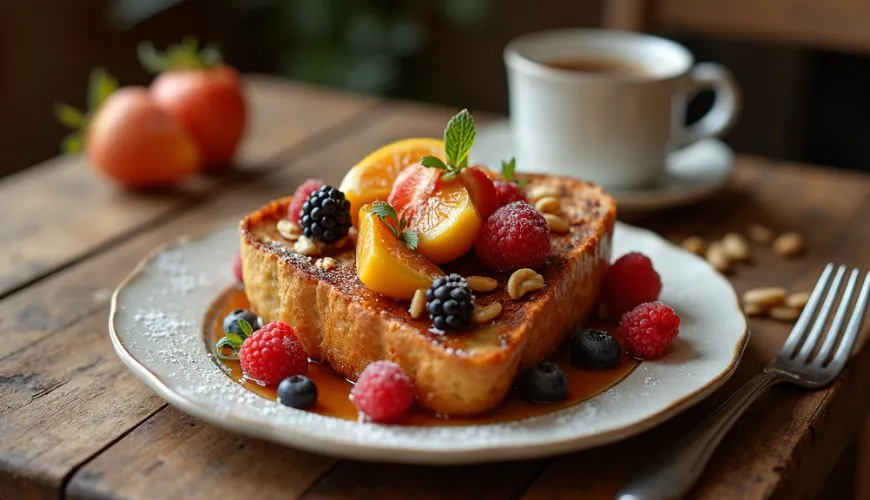
Try an easy recipe for French toast made from vánočka

French Toast from Christmas Bread - When Holiday Pastry Becomes the Perfect Breakfast
The holiday season is full of the aromas of spices, freshly baked cookies, lights, and family gatherings. But what happens when there's half a Christmas bread left on the table after all those feasts, and no one wants to eat it plain? Instead of letting it go stale or — heaven forbid — throwing it away, you can turn it into a true gastronomic delight in just a few minutes: French toast from Christmas bread.
This dish, also known as "pain perdu" or "lost bread," originates from France, where it was originally made as a way to use up older bread. In combination with eggs, milk, a little sugar, and fragrant spices, it can be transformed into a soft, golden toast that tastes like something between a cake and a creamy dessert. And when you use soft, slightly sweet Christmas bread with raisins and buttery flavor instead of plain bread? The result is absolutely irresistible.
Why Christmas Bread?
Traditional Christmas bread, braided from several strands of dough and often enriched with raisins, almonds, or even candied fruit, has the ideal structure for making French toast. It is dense enough to soak up the egg mixture but still retains its softness. There's no need to add sugar—its natural sweetness is enhanced during toasting.
Moreover, Christmas bread holds a strong emotional significance for many of us. It's a pastry associated with childhood, Christmas, and grandma's kitchen. Transforming it into a new dish is not only practical but also a bit nostalgic—as if extending a piece of the holiday atmosphere into a January morning.
When Breakfast Tastes Like Dessert
French toast from Christmas bread is exceptional in that it combines breakfast simplicity with dessert elegance. It looks beautiful on the plate—especially when topped with fresh fruit, nuts, a spoonful of Greek yogurt, or maple syrup—and it fills you up pleasantly. Plus, it takes no more than 15 minutes to prepare.
And let's be honest—few things warm a January morning like a fragrant toast with a hint of vanilla, cinnamon, and butter, made from Christmas bread that you might have baked with your family just a few days ago.
While the classic French toast recipe uses white bread or toast bread, Christmas bread brings something extra to the table. Its buttery dough with a hint of lemon zest or vanilla gives it a depth of flavor that ordinary toast lacks. And thanks to its fluffy texture, it crisps up beautifully on the outside while remaining soft and moist inside.
The Secret to the Perfect Toast
To achieve a truly perfect result, it's good to follow a few simple rules. First and foremost, it's ideal to use Christmas bread that is at least a day old—it holds its shape better and doesn't soak up as much liquid, so it won't fall apart when toasted. The egg-milk mixture should be well-whipped and flavored—vanilla, cinnamon, or a pinch of nutmeg will give the toast a warming aroma.
If you want to create a version that will appeal to those trying to eat healthier, you can replace regular milk with a plant-based alternative, add a bit of coconut sugar, or sweeten with honey. And for toasting, you can use coconut or clarified butter oil (ghee), which will give the toast a gentle nutty tone.
Interestingly, in the United States, this dish is often served with maple syrup and bacon, creating a contrast between sweet and savory. In our country, we tend to lean more towards the sweet variant, but bolder combinations are definitely worth trying.
A Small Miracle from Leftovers
You might know the feeling: after Christmas, a lot of leftovers remain at home, whether it's bread, cookies, or groceries you bought thinking they would be needed more. French toast from Christmas bread is a great example of how to avoid waste while also enjoying something special. Just a few basic ingredients—eggs, milk, a little butter—and you have a dish ready that could easily be part of the brunch menu in a five-star café.
In one family from Brno, they fell in love with this dish so much that they included it in their regular weekend menu even outside the Christmas season. "We freeze slices of Christmas bread, and when we crave something sweet and warm for breakfast, we take them out and toast them straight away," says the mother of three children. "It's quick, nutritious, and the kids love it."
How to Make It at Home
The basic recipe for French toast from Christmas bread is simple. Cut the Christmas bread into slices about 2 cm thick, whisk 2 eggs, 150 ml of milk, a tablespoon of sugar, vanilla extract, and a pinch of cinnamon in a large bowl. Coat the slices of Christmas bread in the mixture and let them soak for a while. Then toast them on both sides in a hot pan with a little butter until golden brown.
If you want to enhance the toast further, you can sprinkle it with chopped nuts, fresh fruit, or drizzle it with maple syrup before serving. It's also great with homemade apple purée or a spoonful of white yogurt with honey. And for festive occasions? Add a few drops of orange liqueur to the egg mixture—the gentle alcoholic flavor beautifully complements the sweetness of the Christmas bread.
More Than Just a Recipe
The magic of French toast from Christmas bread lies not only in the flavors but also in the atmosphere it creates. It's a dish that invites us to slow down for a moment, sit at the table with a warm cup of tea or coffee, and truly enjoy the moment. At a time when breakfast is often just a quick routine between the alarm clock and leaving the house, this toast represents a return to the pleasure of food as an experience.
"Christmas bread has the ability to bring people together. Whether you bake it according to a family recipe or buy it from your favorite bakery, it's a pastry that carries a story," says food stylist and cookbook author Karolína Fourová. "And when you give it a second life as French toast, that story continues—just with a new chapter."
So next time you're holding the last piece of Christmas bread and wondering what to do with it, remember this article. Not only will you enjoy an exceptional breakfast, but you'll also give old pastry a new purpose—and in the spirit of sustainability and the joy of good food, that's the best thing you can do.

